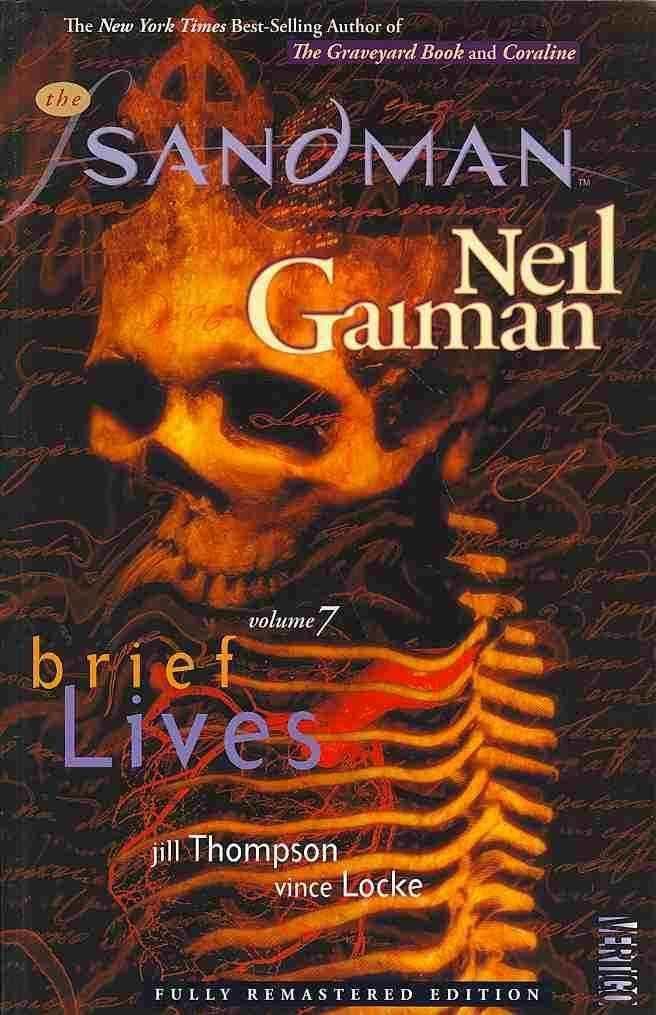Title(s) The Sandman #41-49 ISBN ISBN 1-85286-577-6 Originally published 1994 | Main character(s) Dream | |
 | ||
Publication date September 1992 - May 1993 Genre Dark fantasyMythology in comics Preceded by The Sandman: Fables & Reflections Similar Neil Gaiman books, Other books | ||
Brief Lives (1994) is the seventh collection of issues in the DC Comics series, The Sandman. Written by Neil Gaiman, penciled by Jill Thompson, inked by Vince Locke and Dick Giordano, coloured by Danny Vozzo, lettered by Todd Klein, with cover art by Dave McKean. The introduction was written by Peter Straub but was published as an afterword; Gaiman wrote a brief introduction explaining this.
The issues in the collection, #41-49, first appeared in 1992 and 1993. The collection first appeared in paperback and hardback in 1994.
It was preceded by Fables & Reflections and followed by Worlds' End.
Synopsis
The story revolves around Delirium's wish to reconcile with her brother Destruction. To this end, she first contacts Desire and Despair, each of whom refuses to accompany her on her quest; and finally persuades Dream. According to a list, they consult people who knew Destruction; but each time they leave these people, most are destroyed (such as a 15,000-year-old lawyer killed by part of a building falling on him) or driven into hiding (such as the Alder Man, who changes himself into a bear and has his shadow assume his appearance). After their driver Ruby dies in a fire accidentally caused by herself, Dream has his raven Matthew help Delirium drive their car to a strip club, where Dream consults with Ishtar, a former lover of Destruction. After Dream, Delirium, and Matthew leave, Ishtar performs a furious dance, in which she and the club are destroyed. Realising that the various deaths are caused by their quest, Dream refuses to continue. Delirium secludes herself, and Dream converses with the goddess Bast. Later, Death scolds Dream into accompanying Delirium again. Therefore, Dream and Delirium visit Destiny, who redirects them anew. As they leave, Destiny's book shows a flashback in which Destruction abandoned his realm, as well as a scene showing Dream returning to Earth just prior to his imprisonment; Death visiting a young boy in China; and a white-robed Dream talking with the Corinthian. At Destiny's advice, Dream visits his son Orpheus, who directs them to Destruction in a small cabin, where he makes paintings and writes poetry, criticised by his dog Barnabas.
During dinner, Destruction reveals that rather than allowing himself to be destroyed and have another aspect of himself take over - as had previously happened to Despair - he decided to abandon his realm. Destruction also admits that he placed safeguards up in case someone came looking for him; these safeguards were responsible for the accidents that befell the people who knew him. As they all walk out to view the night sky, Destruction reveals that he once had a conversation with Death, who claimed that everything is already known to everyone, but they all wilfully choose to ignore this information. At length, Destruction dismantles his gallery, shrinks his scrying pool and sword, and orders that Barnabas accompany Delirium, and travels into space. Dream then goes back to visit Orpheus, whom he permits (after millennia) to die. Despair, having regretted not going with Delirium, picks some flowers that sprouted from the blood of Orpheus, and gives one to Desire. In his own realm, Dream orders Andros, the custodian of Orpheus' animated head, to bury Orpheus without a marker. Andros is finally shown burying Orpheus' head under a cherry tree with his son and grandson.
